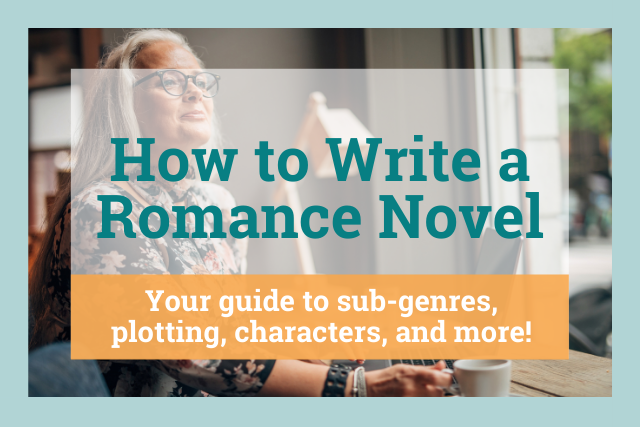
So you want to write a romance novel?
The romance genre has consistently remained one of the best-selling genres of all time and is currently the most lucrative one. People love love, and love sells. It’s no wonder so many authors want to get in on the action.
But if you’ve never written a love story, you might be wondering how to do it. Have no fear. Today we’re going to answer all of your questions. And we’ll take it a step further. You don’t want to write just any romance novel. You want to write a good one.
Before we get down to the heart of the matter (see what I did there?), there’s one piece of writing advice that applies to every genre.
- How Do You Start Writing a Romance Novel?
- What Are the Subgenres of Romance?
- How Do I Choose My Romantic Leads?
- Do I Need World-Building in Romance Writing?
- How Do I Structure a Romance Novel?
- What Are the Most Common Romance Tropes?
- How Do I Pick the Right POV for My Romance Novel?
- Fall in Love with Your Characters
- Do you want to write, publish, and sell a bestselling romance novel?
How Do You Start Writing a Romance Novel?
Read in the genre you want to write.
And read extensively. You need to read the genre to have a full grasp of reader expectations. So, load up your shopping cart with all the romance you can find. Start with the best romance books of all time to get a broad sense of the genre.
All read up? Good. Now we can get to the juicy stuff.
What Are the Subgenres of Romance?
Romance is a wide umbrella. The only essential component of a romance novel is a romantic focus and a happy, or hopeful, ending.
Before you get started, you need to narrow your genre down. Let’s look at some of the popular subgenres of romance.
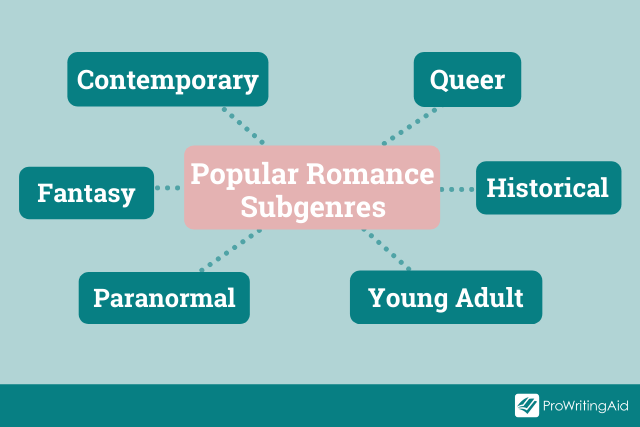
Contemporary Romance
Contemporary romance is the book form of a chick flick. The setting is realistic and familiar, even if it takes place in a fictional town.
Within contemporary romance you might find even more niches, like military romance, mafia romance, billionaire romance, and small-town romance.
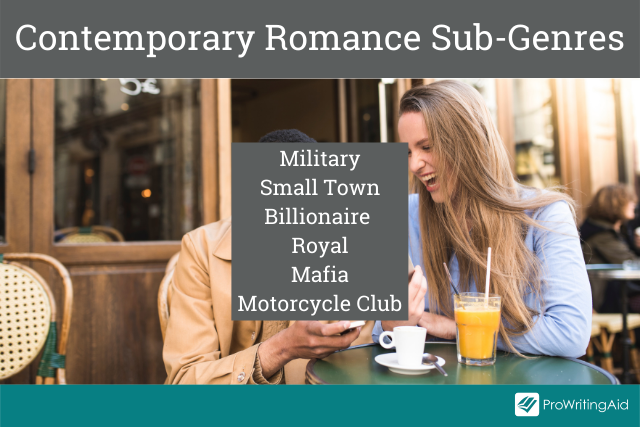
Historical Romance
One of the most popular subgenres is historical romance. You might have heard these referred to as “bodice rippers.” But I’m here to tell you that no bodice has to be ripped to write historical romance.
Any story set more than about fifty years ago is considered historical fiction. Many historical romances take place in the Regency era, such as the Bridgerton series by Julia Quinn.
Wild West romances and World War II romances are also very popular. But romance has happened throughout time and space, so pick the era that feels right.
Paranormal Romance
Werewolves, vampires, shapeshifters. Oh, my! Paranormal romance, often abbreviated to PNR by authors and fans, is any romance that involves the supernatural. Typically, one or both of the main characters is/are a supernatural creature. A Discovery of Witches series by Deborah Harkness is an example of paranormal romance.
Fantasy Romance
If you prefer your love stories to occur in another world full of magic, then fantasy romance is the subgenre for you. When magic occurs in a real-world setting, the line between paranormal and fantasy gets blurry.
If you’ve created an alternative world, you’re writing fantasy.
Within fantasy romance, fae romance is extremely popular. Sarah J. Maas and Holly Black are two bestselling fantasy-romance authors.
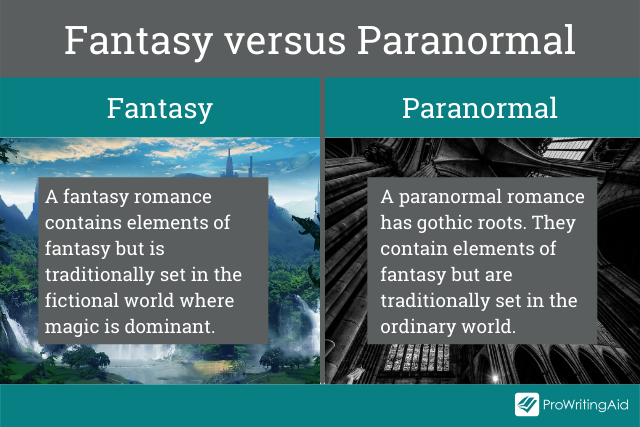
Religious Romance
If you prefer your romance clean with a focus on spirituality, then religious romance might be the way to go. Most religious romances are Christian fiction.
They can be contemporary or historical. Besides the normal plot structure of a romance, one or both of the main characters should also find salvation by the end of the story.
Young Adult Romance
Move over, Romeo and Juliet. The young adult (YA) genre is one of the most lucrative genres out there for writers. It doesn’t appeal to just teenagers. Young adult fiction, especially young adult romance, appeals to readers of all ages.
There’s just something about young love that everyone can relate to. Just look at Divergent by Veronica Roth or The Fault in Our Stars by John Green.
Queer Romance
As the publishing industry continues its push for diversity, queer romance is gaining in popularity. People are glad to have characters that they can relate to falling in love. Rainbow Rowell is one of the bestselling queer romance authors.
Erotic Romance
Most of these genres can feature explicit sex scenes, with the exception of Christian romance and YA romance. But in erotic romance, sex is one of the key points of the story, but the love story is equally important.
In erotica (different to erotic romance) sex is the focal point, and any romance or character development is secondary.
Blending and Bending Genres
You might have noticed some overlap with the genres listed above. For example, Twilight by Stephenie Meyer is a young-adult paranormal romance. You can blend genres in any way that makes sense to you.
You can also bend genres. Take genre expectations and mash them together for something completely unique.
One example is the Sookie Stackhouse series by Charlaine Harris. These books are both paranormal mysteries and paranormal romance. The stories don’t work without both the mystery and romance aspects.
The Outlander series by Diana Gabaldon is steeped in two different eras of history, but the author also throws in time travel for a fantasy element.
Do you want to write a queer, young-adult, sci-fi mystery romance with alien werewolves? Go for it! The sky’s the limit for writing romance. As long as the love story is the most crucial component of the plot, it counts as a romance.
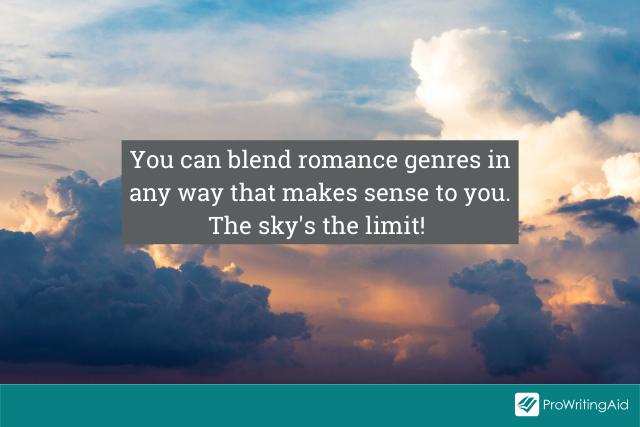
How Do I Choose My Romantic Leads?
A lot of advice about writing romance tells you to pick your setting first. Of course, setting and characters go hand-in-hand. However, romance arcs require strong character growth. For a compelling romance, your story should be primarily character-driven.
What sort of traits do you want your characters to have? Are you writing brooding heroes and brazen heroines? Are your characters rich or poor, timid or outgoing, humble or arrogant?
Your two love interests should have some conflicting personality traits. This creates the interpersonal conflicts that drive the romance forward.
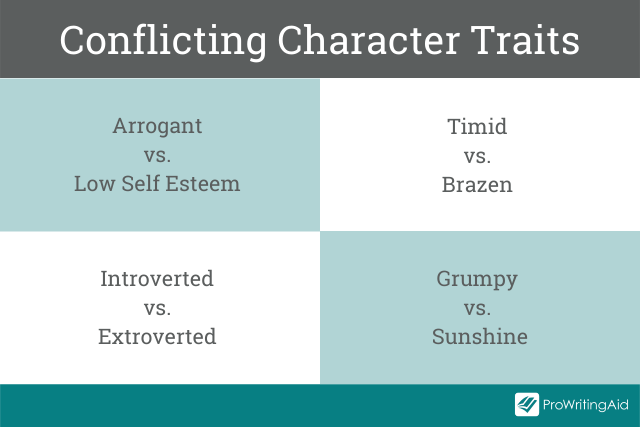
Also, make sure that your heroes and heroines fit the subgenre that you write in. A noble duke might be out of place in your small-town werewolf paranormal romance.
How do you want your characters to grow together? How do you want their love to change each other? The point of a romance is that love makes both main characters better. What character flaws do they overcome by falling in love?
Do I Need World-Building in Romance Writing?
World-building is an important part of any story. You might think you don’t need to focus on world-building if you aren’t writing a fantasy or historical romance. But the world your story takes place in is important, even if it looks like our world.
Setting is crucial to world-building. Setting determines the logistics of your story. What do your characters do for a living? How will they meet? Social expectations and character behaviors are also dictated by setting.
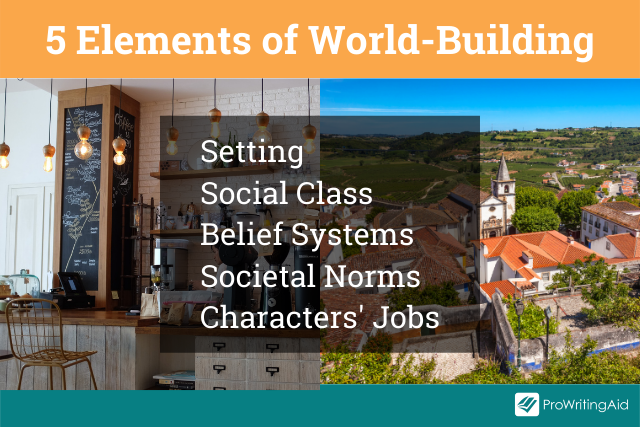
If you’re writing fantasy or paranormal romance, you’ll also need to define your mythology and magic systems and determine how your characters fit into them.
The world-building stage is a great opportunity to find a plot conflict if you haven’t thought of one. In religious romance, the world-building might show you the two different, conflicting belief systems and how they converge in your characters.
In historical romance, you might find class or race differences are a great starting point for conflict.
How Do I Structure a Romance Novel?
You might think all you need for a romance novel is love, right? Well, if you plan on marketing your love story as a romance novel, there are some basic guidelines that avid romance readers expect.
The typical plot structure of a romance novel, in its most basic form, looks something like this:
1) Meet cute
2) Building of romantic tension
3) Couple gets together/almost gets together
4) Couple is torn apart
5) Happily ever after
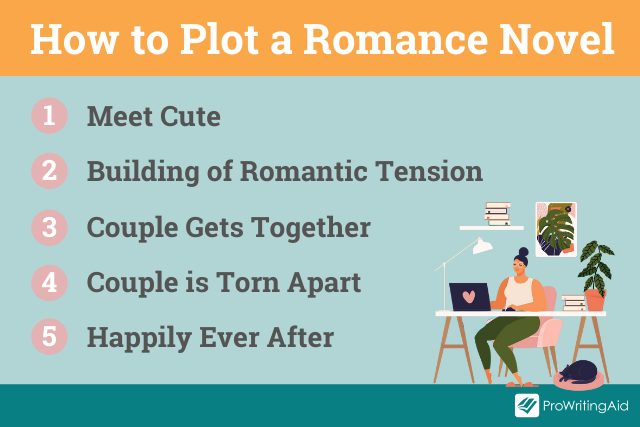
Let’s dive into each of these in greater detail.
Meet Cute
She’s a barista who wants to be an actress. He’s a playboy Hollywood exec who stops by her coffee shop.
He’s an earl with a dark secret. She’s a lady who has secrets of her own. They meet at a ball.
She’s a teacher in a small town. She falls in love with the new, mysterious woman in town after spilling coffee all over the both of them at the Fall Festival.
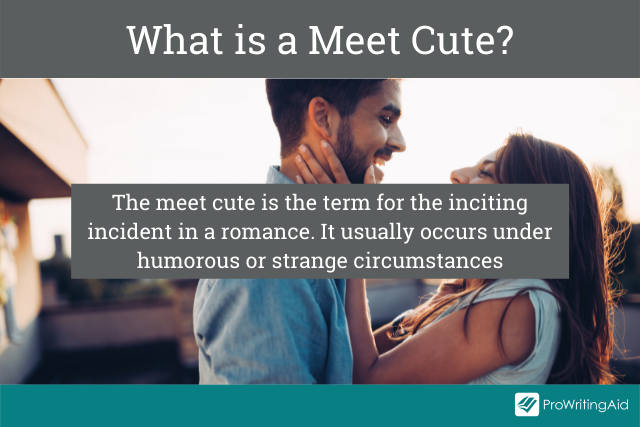
The meet cute is the term for the inciting incident in a romance. How do your characters meet? What draws them together?
The meet cute sets the tone for the entire story. While it doesn’t have to be love at first sight—and probably shouldn’t be for realism’s sake—you must establish strong romantic tension.
They don’t have to like each other at first. You could be writing an enemies-to-lovers story or have a grumpy love interest, but there should be a spark of something.
This is also an important place for characterization. How your characters speak to each other says a lot about their personalities and how their relationship will work. They might lean toward sarcastic banter or heated flirtations.
It’s also where you’ll describe the love interest through the eyes of your main character. Use description in a way that makes sense for the character’s point of view.
Need help with description? Use ProWritingAid’s Sensory Report to help develop the sensory details associated with your characters. It’s important to use all of the five senses and not rely too heavily on a single one.
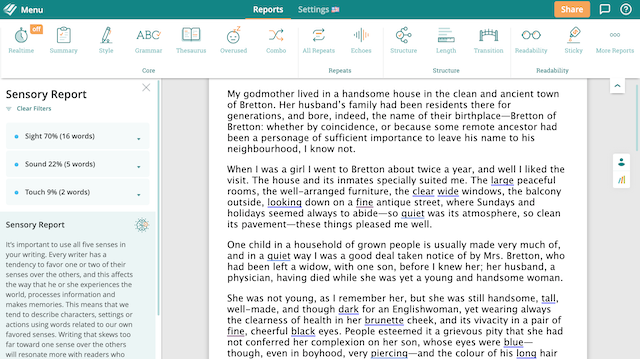
Build the Romantic Tension
Now your characters have to interact so they can develop a relationship. Some plot structures suggest that there should be a minimum of three scenes where they interact before the characters kiss or get together.
Determine what sort of events can draw your characters together. Be sure to give them ample opportunity to be alone together.
Through each scene, make their observations of one another deeper and more intimate. Hint at any emotional wounds or baggage, and show how falling in love might heal them.
Couple Gets Together but Is Torn Apart
Your couple must get together. After all, that’s the whole point of the romance. But your story will be very short and underdeveloped if your happily ever after comes too soon. I’m covering these two plot points together because they are so intertwined.
A first kiss or a tryst is common for this first union in romance. Your couple can date for a while as the external plot progresses, or they may decide that they cannot be together after just one night.
Work within the confines of your world and story to determine what this will look like. Here are a few examples.
The couple spends a night together, but then one is offered their dream job the next morning, and it’s two thousand miles away.
Something nefarious occurs after a kiss, and one of the love interests is kidnapped or is forced to run away.
Their love is forbidden, and they are discovered and pulled apart by family.
One wakes up with guilt because of the nature of their relationship (not accepted by society, is the enemy, is the widow of their childhood best friend, etc.)
How long the couple is able to be together before being inevitably pulled apart depends on the length of your novel and how you want any external plots to develop.
Are they able to meet in secret for months before they are discovered? Or is there just one night of passion before one decides to leave? All of this varies from story to story.
Happily Ever After or Happily for Now
You know how the fairy tales end: “and they all lived happily ever after. The end.” But we can’t end romance novels quite that simply. What does a happy ending look like for your characters?
If there is one plot component that is expected by the vast majority of romance readers, it’s the happy ending.
Happily ever after means that you somehow show or imply that your couple is together forever. Nothing will tear them apart, and the worst of times are behind them. But that might not work for your story.
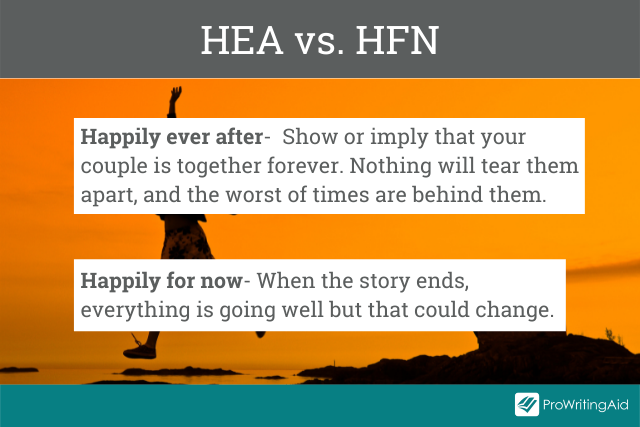
Enter the world of “happily for now.”
It means that when the story ends, everything is going well. However, you don’t allude that everything will be fine in the future.
Sarah J. Maas does this in her series. The first love interests of her main characters are never the endgame relationship. If you’re planning a series, a “happily for now” ending might work well.
What if You Want a Sad Ending?
Some authors have had great success with tearjerker endings, like Nicholas Sparks. In this case, there should have been a “happily for now” or “happily ever after” before the end. In other words, the ending should leave the reader satisfied with the culmination of the romantic relationship.
If one of the characters dies, does the remaining character still have a chance at a happy life? Did the love story change the remaining character for the better?
Tread carefully with non-traditional romance endings. There should still be a degree of happiness at the end of the book. If your story ends too much like a Shakespearean tragedy, your readers will lose trust in you.
What Are the Most Common Romance Tropes?
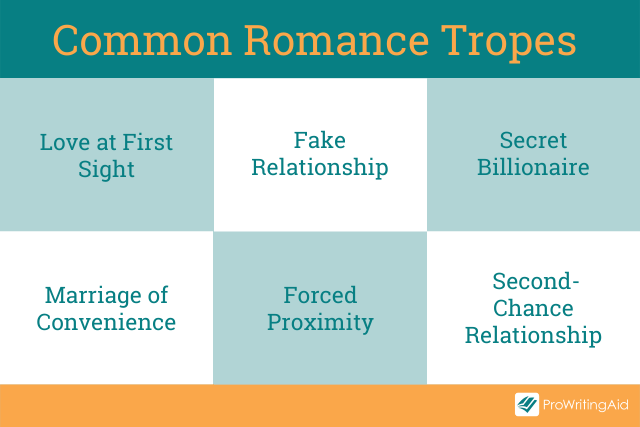
There is an endless number of romance tropes, and they stay popular because people love them.
Of course, tropes that are overused in the same way can become clichéd. Figure out a way to freshen up some of these tropes and use them in a new, creative light.
Romance tropes are great for developing plot and building romantic tension. Here are some well-known romance tropes that stand the test of time.
- Enemies to lovers
- Friends to enemies to lovers
- Friends to lovers
- Marriage of convenience
- Fake relationship
- Arrogant playboy finds his heart
- Forced proximity (roommates, coworkers, hostages, etc.)
- There’s only one bed!
- Secret billionaire/secret royal
- Soul mates
- Love triangles
- Forbidden love
- Girl next door
- Brother/sister’s best friend
- Second chance romance
These are just a few. There are so many tropes you can play with. Mix and match them to create a completely original story!
How Do I Pick the Right POV for My Romance Novel?
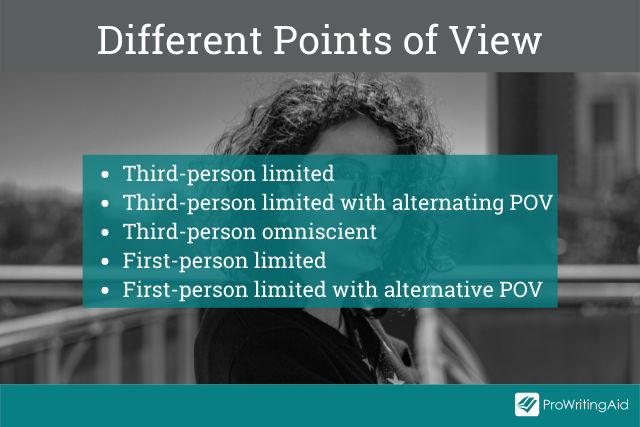
The last major factor when planning and writing your romance novel is the point of view (POV). Alternating POV between two or more lovers is a common occurrence.
Third-person omniscient allows you to get in the heads of not just the couple, but secondary characters as well.
You can write in first or third person. There are advantages and disadvantages to both. All readers have their preferences.
Think about your story without writing. How do you imagine telling this love story? Is it easy for you to see both love interests’ perspectives? Does one character have a stronger arc than the other? Who do you want readers to relate to the most?
It’s okay to start a story in one point of view and realize it’s not working. You can always rewrite scenes with a new POV during editing.
Fall in Love with Your Characters
Most importantly, writing a romance novel should be fun. Write in a way that makes you fall in love with your characters and makes you want them to have a happily ever after. Focus on the emotions rather than the events. Romance readers are in it for the feelings—the angsty, the warm, the cozy, the heart-wrenching.
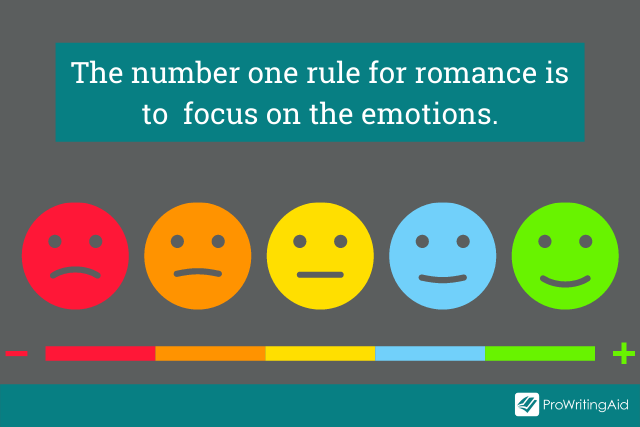
They did just so and all the romance writers lived happily ever after. The end.


